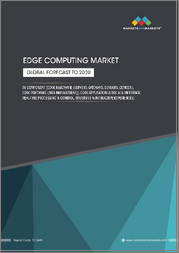
|
시장보고서
상품코드
1666053
세계의 엣지 AI 하드웨어 시장 규모, 점유율, 성장 분석 : 디바이스별, 소비전력별, 프로세서별, 기능별, 업종별, 지역별 - 산업 예측(2025-2032년)Edge AI Hardware Market Size, Share, and Growth Analysis, By Device (Smartphones, Surveillance), By Power Consumptions (Less Than 1 W, 1-3 W), By Processor, By Function, By Vertical, By Region - Industry Forecast 2025-2032 |
||||||
엣지 AI 하드웨어 시장 규모는 2023년 239억 2,000만 달러, 2024년 281억 5,000만 달러에서 2032년에는 1,036억 9,000만 달러로 평가되었고, 예측 기간(2025-2032년) 동안 17.7%의 연평균 복합 성장률(CAGR)을 보일 전망입니다.
엣지 AI 하드웨어 수요는 실시간 데이터 처리가 필요한 엣지 디바이스 및 커넥티드 디바이스의 급속한 보급으로 인해 급증할 것으로 예상됩니다. 사물인터넷(IoT) 기기의 보급과 함께 엣지 AI 하드웨어 공급업체들의 비즈니스 기회가 확대될 것입니다. 에너지 효율에 대한 강조와 하드웨어 기술의 발전은 시장 성장을 더욱 촉진하고, 자율 기술 및 고급 AI 알고리즘의 활용은 매출을 촉진할 것입니다. 또한, 전 세계적으로 AI 전용 하드웨어 개발에 많은 투자가 이루어지고 있어 2032년까지 시장 잠재력을 촉진할 가능성이 높습니다. 그러나 통합의 복잡성, 숙련된 인력 부족, 까다로운 작업 부하에 대한 높은 에너지 소비, 데이터 보안 및 개인 정보 보호에 대한 우려 등의 문제는 조사 기간 동안과 그 이후에도 수요를 저해할 수 있습니다.
목차
서론
- 조사 목적
- 조사 범위
- 정의
조사 방법
- 정보 조달
- 2차와 1차 데이터 방법
- 시장 규모 예측
- 시장 전제조건과 제한
주요 요약
- 세계 시장 전망
- 공급과 수요 동향 분석
- 부문별 기회 분석
시장 역학과 전망
- 시장 개요
- 시장 규모
- 시장 역학
- 성장 촉진요인과 기회
- 성장 억제요인과 과제
- Porter의 Five Forces 분석
주요 시장 인사이트
- 중요 성공 요인
- 경쟁 정도
- 주요 투자 기회
- 시장 생태계
- 시장의 매력 지수(2024년)
- PESTEL 분석
- 거시경제 지표
- 밸류체인 분석
- 가격 분석
- 기술 진보
- 사례 연구
엣지 AI 하드웨어 시장 규모 : 디바이스별&CAGR(2025-2032년)
- 시장 개요
- 스마트폰
- 감시 기기
- 로봇
- 웨어러블
- 엣지 서버
- 스마트 스피커
- 자동차
- 기타 디바이스
엣지 AI 하드웨어 시장 규모 : 소비전력별&CAGR(2025-2032년)
- 시장 개요
- 1W 미만
- 1-3W
- 3-5W
- 5-10W
- 10W 이상
엣지 AI 하드웨어 시장 규모 : 프로세서별&CAGR(2025-2032년)
- 시장 개요
- 중앙 처리장치
- 그래픽 처리장치
- 주문형 집적회로
- 기타 프로세서
엣지 AI 하드웨어 시장 규모 : 기능별&CAGR(2025-2032년)
- 시장 개요
- 트레이닝
- 추론
엣지 AI 하드웨어 시장 규모 : 업종별&CAGR(2025-2032년)
- 시장 개요
- 가전
- 스마트폰
- 웨어러블
- 엔터테인먼트 로봇
- 스마트홈
- 스마트 스피커
- 스마트 카메라
- 가정용 로봇
- 자동차 및 운송
- 자동차 부품
- 감시 카메라
- 물류 로봇
- 기타 자동차 및 운송
- 정부
- 감시 카메라
- 드론
- 헬스케어
- 의료 로봇
- 웨어러블
- 기타 헬스케어 기기
- 산업
- 산업용 로봇
- 드론
- MV 카메라
- 항공우주 및 방위
- 서비스 로봇
- 기타 항공우주 및 방위 기기
- 건설
- 서비스 로봇
- 드론
- 기타 업종
- 디바이스
- 감시 카메라
- 전문 서비스 로봇
- 웨어러블
- 기타 디바이스
- 엣지 서버
- 드론
엣지 AI 하드웨어 시장 규모 : 지역별&CAGR(2025-2032년)
- 북미
- 미국
- 캐나다
- 유럽
- 독일
- 스페인
- 프랑스
- 영국
- 이탈리아
- 기타 유럽
- 아시아태평양
- 중국
- 인도
- 일본
- 한국
- 기타 아시아태평양
- 라틴아메리카
- 브라질
- 기타 라틴아메리카
- 중동 및 아프리카
- GCC 국가
- 남아프리카공화국
- 기타 중동 및 아프리카
경쟁 정보
- 주요 5개사 비교
- 주요 기업의 시장 포지셔닝(2024년)
- 주요 시장 기업이 채택한 전략
- 최근 시장 동향
- 기업의 시장 점유율 분석(2024년)
- 주요 기업 개요
- 기업 상세
- 제품 포트폴리오 분석
- 기업 부문별 점유율 분석
- 매출 전년대비 비교(2022-2024)
주요 기업 개요
- NVIDIA Corporation(United States)
- Intel Corporation(United States)
- Qualcomm Technologies, Inc.(United States)
- Apple Inc.(United States)
- Advanced Micro Devices, Inc.(AMD)(United States)
- IBM Corporation(United States)
- Google LLC(Alphabet Inc.)(United States)
- Microsoft Corporation(United States)
- Micron Technology, Inc.(United States)
- Samsung Electronics Co., Ltd.(South Korea)
- Huawei Technologies Co., Ltd.(China)
- MediaTek Inc.(Taiwan)
- Arm Limited(United Kingdom)
- Baidu, Inc.(China)
- Alibaba Group Holding Limited(China)
- Sony Corporation(Japan)
- Fujitsu Limited(Japan)
- Renesas Electronics Corporation(Japan)
- Cerebras Systems(United States)
결론과 제안
LSH 25.04.03Edge AI Hardware Market size was valued at USD 23.92 billion in 2023 and is poised to grow from USD 28.15 billion in 2024 to USD 103.69 billion by 2032, growing at a CAGR of 17.7% during the forecast period (2025-2032).
The demand for edge AI hardware is expected to surge, driven by the rapid adoption of edge and connected devices, which necessitates real-time data processing. As Internet of Things (IoT) devices proliferate, opportunities for edge AI hardware providers will expand. Emphasis on energy efficiency and improvements in hardware technology will further enhance market growth, while the increasing use of autonomous technologies and advanced AI algorithms will stimulate sales. Furthermore, significant investments in AI-specific hardware development worldwide are likely to propel market potential through 2032. However, challenges such as integration complexity, a shortage of skilled workers, high energy consumption for demanding workloads, and concerns regarding data security and privacy may hinder demand throughout the study period and beyond.
Top-down and bottom-up approaches were used to estimate and validate the size of the Edge Ai Hardware market and to estimate the size of various other dependent submarkets. The research methodology used to estimate the market size includes the following details: The key players in the market were identified through secondary research, and their market shares in the respective regions were determined through primary and secondary research. This entire procedure includes the study of the annual and financial reports of the top market players and extensive interviews for key insights from industry leaders such as CEOs, VPs, directors, and marketing executives. All percentage shares split, and breakdowns were determined using secondary sources and verified through Primary sources. All possible parameters that affect the markets covered in this research study have been accounted for, viewed in extensive detail, verified through primary research, and analyzed to get the final quantitative and qualitative data.
Edge Ai Hardware Market Segments Analysis
Global Edge AI Hardware Market is segmented by Device, Power Consumptions, Processor, Function, Vertical and region. Based on Device, the market is segmented into Smartphones, Surveillance, Robots, Wearables, Edge Servers, Smart Speakers, Automobiles and Other Devices. Based on Power Consumptions, the market is segmented into Less Than 1 W, 1-3 W, 3-5 W, 5-10 W and More Than 10 W. Based on Processor, the market is segmented into Central Processing Units, Graphics Processing Units, Application Specific Integrated Circuits and Other Processors. Based on Function, the market is segmented into Training and Inference. Based on Vertical, the market is segmented into Consumer Electronics, Smart Homes, Automotive & Transportation, Government, Healthcare, Industrial, Aerospace & Defense, Construction and Other verticals. Based on region, the market is segmented into North America, Europe, Asia Pacific, Latin America and Middle East & Africa.
Driver of the Edge Ai Hardware Market
The increasing necessity for real-time data processing, which minimizes delays across various applications, is expected to significantly enhance the sales of edge AI hardware in the upcoming years. Key sectors such as autonomous vehicles, industrial automation, and smart city developments rely heavily on swift decision-making capabilities. As the demand for efficient and immediate data handling in these critical applications rises, it is likely to be a primary factor propelling the growth of the global edge AI hardware market in the foreseeable future. This trend highlights the essential nature of edge AI solutions in advancing technology across multiple industries.
Restraints in the Edge Ai Hardware Market
The Edge AI Hardware market is currently facing a significant challenge due to a shortage of skilled professionals needed to design and manage advanced edge AI hardware solutions. This lack of expertise is projected to hinder the long-term sales and growth of edge AI hardware products. Emerging markets are likely to be more adversely affected by this constraint than their developed counterparts within the global edge AI hardware industry, particularly as we move toward 2032. The scarcity of qualified personnel not only impacts product innovation and deployment but also raises concerns about the overall development of the sector in these regions.
Market Trends of the Edge Ai Hardware Market
The emergence of TinyML is significantly shaping the Edge AI Hardware market, as it facilitates the deployment of machine learning models on ultra-low-power devices, enabling intelligent processing directly at the source of data generation. This trend presents substantial growth opportunities for companies committed to advancing TinyML algorithms and models, driving innovation in edge computing capabilities. By investing in this technology, edge AI hardware manufacturers can enhance the functionality and efficiency of their products, ultimately leading to increased revenue generation and market competitiveness. As applications across industries-from smart homes to industrial IoT-require real-time insights with minimal power consumption, TinyML is poised to revolutionize the edge AI landscape.
Table of Contents
Introduction
- Objectives of the Study
- Scope of the Report
- Definitions
Research Methodology
- Information Procurement
- Secondary & Primary Data Methods
- Market Size Estimation
- Market Assumptions & Limitations
Executive Summary
- Global Market Outlook
- Supply & Demand Trend Analysis
- Segmental Opportunity Analysis
Market Dynamics & Outlook
- Market Overview
- Market Size
- Market Dynamics
- Drivers & Opportunities
- Restraints & Challenges
- Porters Analysis
- Competitive rivalry
- Threat of substitute
- Bargaining power of buyers
- Threat of new entrants
- Bargaining power of suppliers
Key Market Insights
- Key Success Factors
- Degree of Competition
- Top Investment Pockets
- Market Ecosystem
- Market Attractiveness Index, 2024
- PESTEL Analysis
- Macro-Economic Indicators
- Value Chain Analysis
- Pricing Analysis
- Technological Advancement
- Case Studies
Global Edge AI Hardware Market Size by Device & CAGR (2025-2032)
- Market Overview
- Smartphones
- Surveillance
- Robots
- Wearables
- Edge Servers
- Smart Speakers
- Automobiles
- Other Devices
Global Edge AI Hardware Market Size by Power Consumptions & CAGR (2025-2032)
- Market Overview
- Less Than 1 W
- 1-3 W
- 3-5 W
- 5-10 W
- More Than 10 W
Global Edge AI Hardware Market Size by Processor & CAGR (2025-2032)
- Market Overview
- Central Processing Units
- Graphics Processing Units
- Application Specific Integrated Circuits
- Other Processors
Global Edge AI Hardware Market Size by Function & CAGR (2025-2032)
- Market Overview
- Training
- Inference
Global Edge AI Hardware Market Size by Vertical & CAGR (2025-2032)
- Market Overview
- Consumer Electronics
- Smartphones
- Wearables
- Entertainment robots
- Smart Homes
- Smart speakers
- Smart cameras
- Domestic robots
- Automotive & Transportation
- Automobile Parts
- Surveillance Cameras
- Logistics Robots
- Other Automotive & Transportation Devices
- Government
- Surveillance Cameras
- Drones
- Healthcare
- Medical Robots
- Wearables
- Other Healthcare Devices
- Industrial
- Industrial Robots
- Drones
- Mv Cameras
- Aerospace & Defense
- Service Robots
- Other Aerospace & Defense Devices
- Construction
- Service Robots
- Drones
- Other verticals
- Device
- Surveillance Cameras
- Professional Service Robots
- Wearables
- Other Devices
- Edge Servers
- Drones
Global Edge AI Hardware Market Size & CAGR (2025-2032)
- North America (Device, Power Consumptions, Processor, Function, Vertical)
- US
- Canada
- Europe (Device, Power Consumptions, Processor, Function, Vertical)
- Germany
- Spain
- France
- UK
- Italy
- Rest of Europe
- Asia Pacific (Device, Power Consumptions, Processor, Function, Vertical)
- China
- India
- Japan
- South Korea
- Rest of Asia-Pacific
- Latin America (Device, Power Consumptions, Processor, Function, Vertical)
- Brazil
- Rest of Latin America
- Middle East & Africa (Device, Power Consumptions, Processor, Function, Vertical)
- GCC Countries
- South Africa
- Rest of Middle East & Africa
Competitive Intelligence
- Top 5 Player Comparison
- Market Positioning of Key Players, 2024
- Strategies Adopted by Key Market Players
- Recent Developments in the Market
- Company Market Share Analysis, 2024
- Company Profiles of All Key Players
- Company Details
- Product Portfolio Analysis
- Company's Segmental Share Analysis
- Revenue Y-O-Y Comparison (2022-2024)
Key Company Profiles
- NVIDIA Corporation (United States)
- Company Overview
- Business Segment Overview
- Financial Updates
- Key Developments
- Intel Corporation (United States)
- Company Overview
- Business Segment Overview
- Financial Updates
- Key Developments
- Qualcomm Technologies, Inc. (United States)
- Company Overview
- Business Segment Overview
- Financial Updates
- Key Developments
- Apple Inc. (United States)
- Company Overview
- Business Segment Overview
- Financial Updates
- Key Developments
- Advanced Micro Devices, Inc. (AMD) (United States)
- Company Overview
- Business Segment Overview
- Financial Updates
- Key Developments
- IBM Corporation (United States)
- Company Overview
- Business Segment Overview
- Financial Updates
- Key Developments
- Google LLC (Alphabet Inc.) (United States)
- Company Overview
- Business Segment Overview
- Financial Updates
- Key Developments
- Microsoft Corporation (United States)
- Company Overview
- Business Segment Overview
- Financial Updates
- Key Developments
- Micron Technology, Inc. (United States)
- Company Overview
- Business Segment Overview
- Financial Updates
- Key Developments
- Samsung Electronics Co., Ltd. (South Korea)
- Company Overview
- Business Segment Overview
- Financial Updates
- Key Developments
- Huawei Technologies Co., Ltd. (China)
- Company Overview
- Business Segment Overview
- Financial Updates
- Key Developments
- MediaTek Inc. (Taiwan)
- Company Overview
- Business Segment Overview
- Financial Updates
- Key Developments
- Arm Limited (United Kingdom)
- Company Overview
- Business Segment Overview
- Financial Updates
- Key Developments
- Baidu, Inc. (China)
- Company Overview
- Business Segment Overview
- Financial Updates
- Key Developments
- Alibaba Group Holding Limited (China)
- Company Overview
- Business Segment Overview
- Financial Updates
- Key Developments
- Sony Corporation (Japan)
- Company Overview
- Business Segment Overview
- Financial Updates
- Key Developments
- Fujitsu Limited (Japan)
- Company Overview
- Business Segment Overview
- Financial Updates
- Key Developments
- Renesas Electronics Corporation (Japan)
- Company Overview
- Business Segment Overview
- Financial Updates
- Key Developments
- Cerebras Systems (United States)
- Company Overview
- Business Segment Overview
- Financial Updates
- Key Developments



















